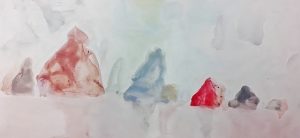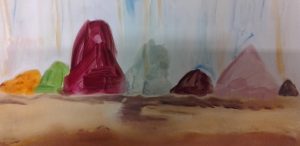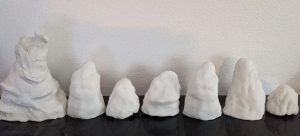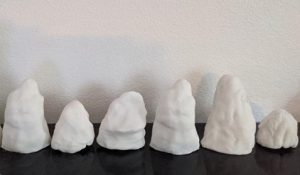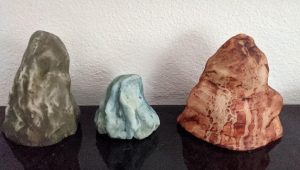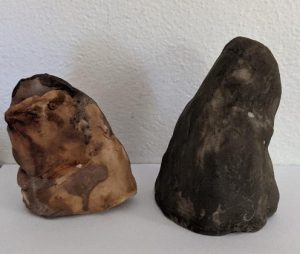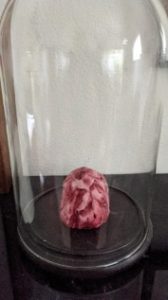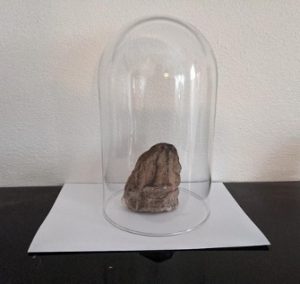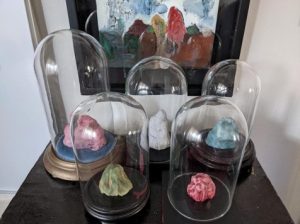An Artists Statement
By Tony Scott
A resin 3D Printer gives an artist a new canvas, allowing for intricate and tangible representations of their creative visions, and this technology felt like the perfect way to transform my 2D works into more substantial 3D forms. When developing my concept for the “Journey to Portland” exhibition, I wanted to feature the visually striking geological features called The Twelve Apostles found along the Great Ocean Road on the journey to Portland from Melbourne.


“I wanted to present the 2D work in a more substantial representation; the 3D printing resins offered by Monocure3D in Sydney seemed an interesting solution.”
A series of 10 rocks and mountains had already been meticulously shaped in clay as part of my envisioned installation. These sculptures were inspired by the geological features that informed my earlier work, and I was eager to explore new ways to bring them to life. The idea of incorporating “new technology” into my creative process—specifically 3D printing—was intriguing. It felt like a natural evolution for this project, offering a modern approach to reinterpreting my hand-formed clay pieces.
To test the feasibility and quality of this method, I selected six of the more miniature sculptures from the series and sent them to Sydney to be 3D scanned and printed. I chose to work with Monocure3D, known for their advanced resin materials, including a white pigmented resin that perfectly suited my vision for the project.
The results were remarkable. The 3D scanning process captured every detail of the original clay forms, from the subtle textures to the precise contours. The 3D-printed reproductions were flawless, replicating the sculptures with a fidelity that exceeded my expectations. Seeing these forms translated into a new medium while maintaining their integrity was an exciting moment. Even more thrilling was how well the printed sculptures harmonised with the original paintings they were designed to complement.
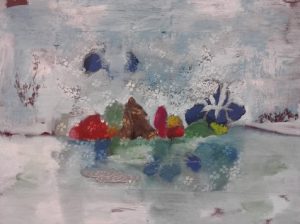
The next phase of experimentation focused on surface treatment. I was particularly interested in how the resin material would respond to paint—specifically, oil paint and oil pigments. My goal was to replicate the painterly effects and rich surface quality of my 2D paintings on these three-dimensional forms.
As I applied the oil paint and pigments, I discovered they adhered to the resin surface beautifully. The material accepted the paint just as I had hoped, allowing me to match the textures and tonal variations of the original works. The pigments interacted with the surface in a way that retained the depth and character of the clay originals while introducing a new dimension to the sculptures.
Combining traditional techniques with cutting-edge technology has opened up new possibilities for my work. The interplay between the clay forms, the precision of 3D printing, and the painterly quality of oil pigments has allowed me to create pieces that bridge the gap between traditional craftsmanship and modern innovation.
The Clay shapes were 3D Scanned and 3D Printed using a white pigmented resin from Monocure3D.
“A series of 6 small sculptures were sent to Sydney, and I was delighted with the 3D scanning & 3D printing results.
The next experiment was how the material in the printing would take paint – in this case, I wanted to use oil paint & oil pigment to match as closely as I could the surface and painterly effects in the 2D paintings. The oil paint and oil pigment reacted and adhered to the resin surface of the shapes exactly as I had hoped.
Oil painting on 3D printed shapes
“They were perfect reproductions of the sculptures and matched the original paintings beautifully.”
I am now experimenting with integrating the 2D and 3D work into a visual installation for the Journey to Portland exhibition (regional Victoria) in November and an exhibition at Glen Eira City Gallery, Melbourne, in September 2021. Thanks to the team at Monocure3D for introducing me to the new world of 3D printing. This might be the latest canvas for many artists; I will use this medium again very soon; it is true that a resin 3D Printer gives an artist a new canvas.
Installed in Vitrines to go in front of 2D paintings as complete artworks
“A Resin 3D Printer gives an artist a new canvas, allowing for intricate and tangible representations of their creative visions”
